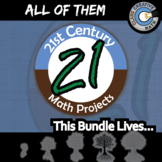Archaeological Dig - Carbon Dating Exponential & Log - 21st Century Math Project
- Zip
What educators are saying
Also included in
- This is a selection of my Exponential & Logarithmic Function resources all in a money saving Essential Bundle! You save significant money and time versus purchasing these separately!Essential Bundles are designed to give you everything you need to rock your unit. Warmups, Notes, Activities, GamePrice $35.00Original Price $86.00Save $51.00
- The project is the core of what I have built my classroom around. Scaffolding learners to real world projects. This bundle includes the 105+ math projects I have written. This is over 2,700 pages of content.21st Century Math Projects each scaffold through an authentic context and math skill buildingPrice $395.00Original Price $564.00Save $169.00
- 12 of my best selling projects/units all in an organized money saving bundle! These engaging, student/teacher approved math projects that provide rigor, relevance, and cross-curricular content altogether. Want more projects?•21st Century Math Projects -- All the Projects•More Algebra 2 / Pre-CalculuPrice $45.00Original Price $69.00Save $24.00
Description
Invented in the 1940s by Willard Libby, carbon dating is a process by which archaeologists measure the carbon-14 content in a fossil to determine its approximate age. People and animals acquire carbon-14 by eating plants and animals. Once an organism dies, the amount of carbon-14 in the organism begins to decay.
Turn your Algebra 2 or Pre-Calculus into an Archaeological Research Lab with this 21st Century Math Project. Students will use exponential and logarithmic functions to determine dates of ancient fossils.
In this 14 page document you will be given a mapping to the Content Standards, an outline for how to implement the project, handout resources for students to use, and an answer key. ***THIS PRODUCT HAS BEEN UPDATED WITH A GOOGLE SLIDES INTERACTIVE VERSION INCLUDED. REDOWNLOAD IF YOU HAVE IT ALREADY***
In all it is three different assignments --
-- In “Half Life” students will use lab observations to calculate the half-life of 5 mysterious elements. They’ll use this measurement to determine what the mystery element was.
-- In “Carbon Dating” students will determine whether five artifacts are possibly authentic or fakes. Using the half-life of carbon-14, students will use the half-life formula to calculate the approximate age of the artifacts and compare the dates to the dates of the ancient civilizations.
-- In “Archaeological Dig” students be given information about 7 authentic artifacts and must calculate the ages of the samples using carbon-14 dating and will be asked to summarize their findings based on their research.
You may be interested in the following discounted bundles. SAVE $$$!
•Exponential, Logistic & Logarithmic Functions
•21st Century Math Projects -- All the Projects
Need an Entire Curriculum?
•21st Century Algebra –- the Entire Curriculum
•21st Century Algebra 2 / Pre-Calculus –- the Entire Curriculum
For more tips, tricks and ideas check out the Clark Creative Education Blog
And join our community where I post ideas, anecdotes, elaborations & every once in a while I pass out TPT gift cards! And jokes! I do jokes too!








